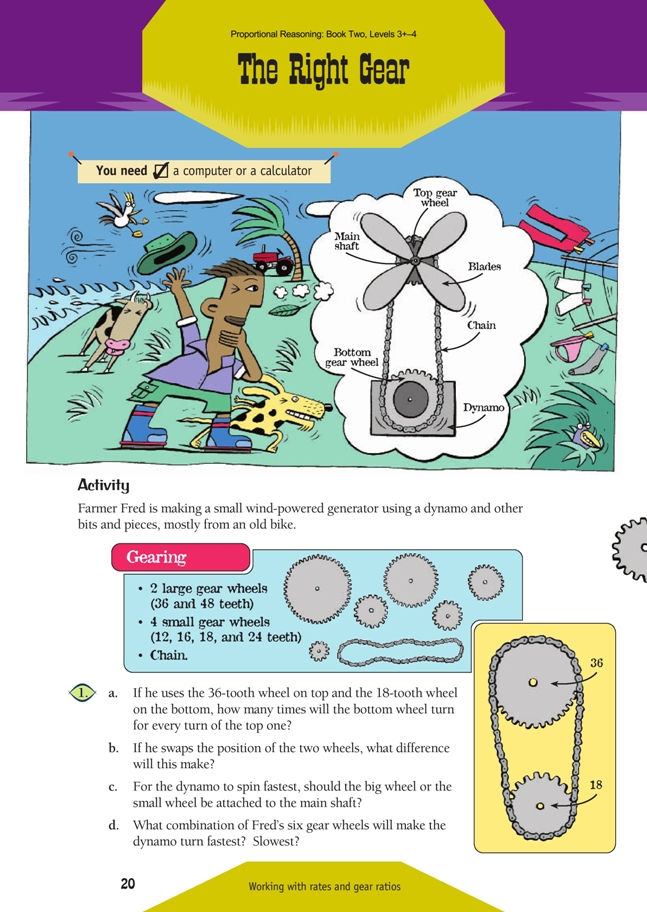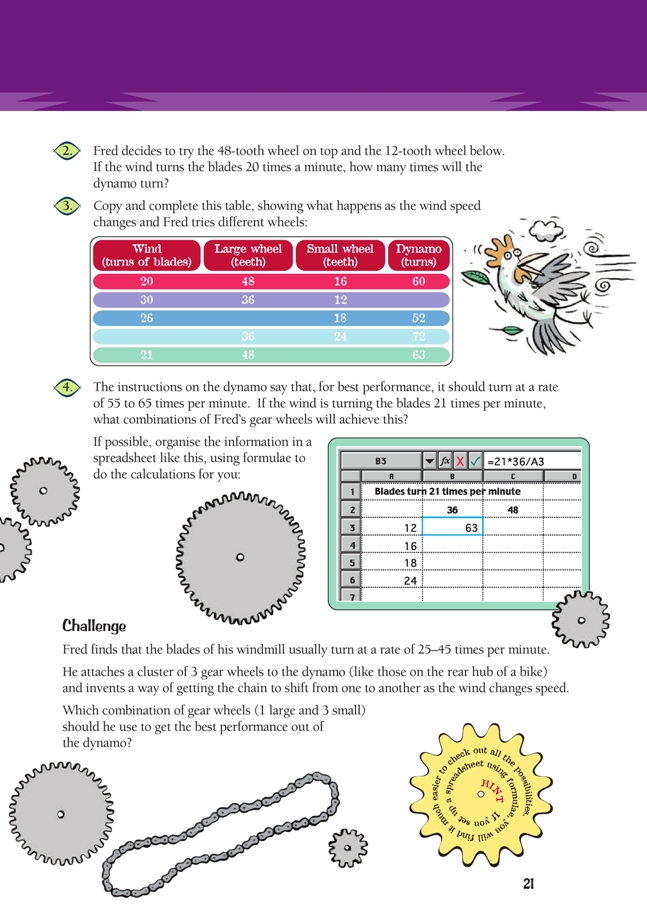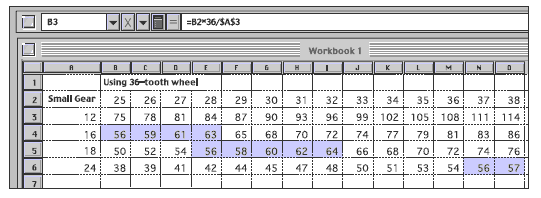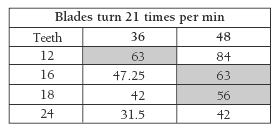This is a level 5 number activity from the Figure It Out series. It relates to Stage 8 of the Number Framework.
A PDF of the student activity is included.
Click on the image to enlarge it. Click again to close. Download PDF (1159 KB)
solve problems involving gear ratios
solve problems involving rates
Number Framework Links
Use this activity to:
• help students consolidate and apply their knowledge of equivalent fractions (stage 7)
• develop confidence in students who are beginning to use advanced proportional strategies (stage 8).
A computer or a calculator
This activity provides a great context for an exploration of ratio. All students will have had some experience of gears on bicycles. Many will also have come across gears in construction sets. Educational suppliers have sets of plastic gears for sale and, if possible, you should have one of these sets available in your classroom.
Some important understandings:
• Gear wheels are often described by the number of teeth they have (for example, a
24-tooth wheel).
• Gear wheels can be joined by a chain. The effect is exactly the same as if they were
meshed (teeth interlocked). Gear wheels designed to fit a chain are often called sprockets.
• If two wheels are meshed, the rate at which one turns the other is determined by the
number of teeth each has. This is often expressed as a ratio, for example: 1:3.
• If a wheel with 12 teeth is driving a wheel with 36 teeth, the small wheel will have to
turn exactly 3 times to make the big wheel turn once. And if the large wheel is driving
the small one, the small wheel will turn exactly 3 times for every turn of the large one.
• If the ratio between the teeth of two wheels is 1:3 (as in the example above), the turns ratio will be 3:1.
Question 1 is designed to check whether students understand the basics or need help before moving on to question 2 and beyond.
In question 2, they have to consider the combined effect of gear ratio and wind speed in a straightforward calculation that is intended to prepare them for the more complex problems that follow. Ask the students to explain how they will use the information. Encourage them to simplify the ratio to keep the calculation as easy as possible: 48:12 = 4:1, so 1 turn of the blades will turn the dynamo 4 times, and 20 turns of the blades will turn the dynamo 20 x 4 = 80 times.
Question 3 gives students practice with wind speed : gear ratio calculations of the kind they met in question 2. The first line in the table has been completed as a model.
As an extra, you could show your students how multiplying pairs of numbers in the columns can reveal another equivalent relationship. They should find that wind speed x large wheel = small wheel x dynamo. This generalisation can be used to check each row. For example: 30 x 36 = 12 x , which means that 1 080 = 12 x , which means that = 1 080 ÷ 12 = 90.
When introducing question 4, ask the students “What wind speed to dynamo ratio do we need for best performance?” They should see that it is between 21:55 and 21:65. This is around 1:3, so they should identify combinations of wheels that are in the ratio 3:1, or very close. They are 36:12, 48:16, and 48:18.
If your students use a spreadsheet as suggested, they should examine the formula (=21*36/A3) and generalise the connections it makes: dynamo speed = wind speed x large gear ÷ small gear. This formula is applied to each row.
Challenge
This is a demanding problem. Students should spend time looking for a strategy that won’t involve individually testing each combination of gears. Ask “How can we use the wind speed range to help us find the range of gear wheels needed?” A good reply would be: “If we can find which gears work for the slowest wind speed and which gears work for the highest wind speed, we should have the combination that will work best for the in-between wind speeds.”
For a wind speed of 25, we need a ratio of between 1 : 2.2 (for a dynamo speed of 55) and 1 : 2.6 (for a dynamo speed of 65). For a wind speed of 45, we need a ratio of between 1 : 1.2 and 1 : 1.5. No 3-gear combination will work with the 48-tooth wheel because only one small gear (24-tooth) fits within the required range. The only small gear that will not work with the 36-tooth gear is the 12-tooth one (36:12 is 3:1), so the three other gears (16-, 18-, and 24-tooth) must be the cluster
we are looking for. Calculations will confirm this.
An alternative method of solving this problem is to set up a spreadsheet, as suggested in the activity. Here is part of a suitable spreadsheet:
The heart of the spreadsheet is the formula used to calculate the speed of the dnamo. The screenshot hows the formula that has been entered in cell B3; similar formulae must be entered in B4, B5, nd B6 and then filled along each row. Students may not be familiar with the meaning of $A$3. This is what is known as an absolute cell reference and tells the program to keep referring back to the number in cell A3. To make a cell reference absolute, highlight it in the formula bar and press F4 (PC) or Apple T (Macintosh). Cells with values between 55 and 65 have been highlighted
automatically using the Conditional Formatting option, found under Format on the menu bar.
Answers to Activity
1. a. 2 times
b. The top wheel will now have to turn twice to make the bottom wheel turn once.
c. The big wheel should be attached to the main shaft.
d. Fastest: 48-tooth wheel on the main shaft and the 12-tooth wheel on the dynamo.
Slowest: 12-tooth wheel on the main shaft and the 48-tooth wheel on the dynamo.
2. 80 times. (48/12 = 4. 20 x 4 = 80)
3.
4. Three combinations are possible
Challenge
The best performance comes from using the 36-tooth wheel together with the 16-, 18-, and 24-tooth wheels:
Note that Fred can’t use the 48-tooth wheel because, even at its lowest gearing (using the 24-tooth wheel on the dynamo), it can only provide the right performance in winds that turn the blades at up to 32 times per min.





